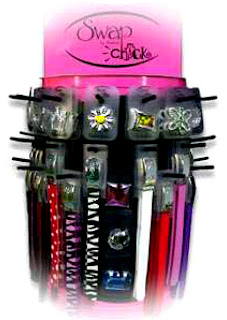E. D. Va. District Court Affirms TTAB Dismissal of SWATCH Opposition versus SWAP
In a civil action for review under 15 U.S.C. Section 1071(b), the United States District Court for the Eastern District of Virginia has affirmed the TTAB's dismissal of Swatch, S.A.'s opposition to registration of the mark SWAP in stylized form for "watch faces, watch bands, slide pendants, and beaded watch bands." [TTABlogged here]. The Board found applicant's mark to be not merely descriptive of the goods and not likely to cause confusion with or to dilute the registered mark SWATCH for watches, clocks, and parts. The court entered judgment against Swatch on its six claims: for reversal of the TTAB decision, and for federal and state trademark infringement and unfair competition, and federal dilution. Swatch, S.A. v. Beehive Wholesale, L.L.C., Civil Action No. 1:11-cv-434 (E.D. Va. August 16, 2012).

The district court noted that, although appellate review of a TTAB decision is limited to the record before the Board, a civil action for review affords litigants the opportunity to introduce new evidence. Moreover, although the appeal is heard by the CAFC and is governed by the law of the Federal Circuit, appeals from this district court are heard by the Fourth Circuit, and so the Fourth Circuit's nine factor test for likelihood of confusion is applicable.
In addition, while the district court is an "appellate reviewer" of facts found by the TTAB (applying a substantial evidence standard), the court is a fact finder as to new evidence and issues presented.
Likelihood of confusion: Most of Swatch's claims hinged on its proving likelihood of confusion. The court found the SWATCH mark to be both conceptually and commercially strong. But it agreed with the TTAB that the marks SWATCH and SWAP are "insufficiently similar in sign sound and meaning," and it further found that the marks as used are dissimilar.
As to the goods, there is a similarity between the general types of goods sold under the marks, and even if they are not "related," the goods sold under the SWAP mark are "associated" with the market for goods identified by the SWATCH mark. There was a de mimimis overlap in channels of trade, and no overlap in advertising channels. And despite Applicant/Defendant's awareness of the SWATCH mark when it adopted the SWAP mark, the TTAB was correct in concluding that the evidence was insufficient to support a finding of bad faith.
Most importantly, there was no evidence of actual confusion, and this factor weighed heavily against a finding of likelihood of confusion.
Combining the lack of actual confusion with the lack of similarity between the marks, the lack of predatory intent, the lack of similar advertising and only minimal similarity in facilities, the court found no likelihood of confusion. It therefore affirmed the TTAB's judgment as to likelihood of confusion, and entered judgment against Swatch on its infringement and unfair competition claims.
Dilution by blurring: The court found that, even assuming that the SWATCH mark is famous and was famous at the time Applicant commenced use of its mark, and even assuming that "a similarity" between the marks "gives rise to an association between the marks," Swatch failed to show that the distinctiveness of its mark would likely be impaired by Defendant's use of its SWAP mark. (citing Rosetta Stone Ltd. v. Google, Inc.., 676 F.3d 144, 153-54 (4th Circuit 2012)
Looking to the six non-exhaustive factors of Section 43(c)(1)(B)(1), the court found insufficient similarity between the marks, no evidence that Defendant intended to associate with the SWATCH mark, and no actual association between the marks. "In sum, Plaintiff falls far short of meeting its burden of showing that SWAP's mark impacts its ability to be 'uniquely' identified as the single source of the products using its famous mark."
Descriptiveness: The court found the TTAB's ruling to be supported by substantial evidence, and Plaintiff's new evidence "does nothing to alter the conclusion that Swap is suggestive and properly registrable."
TTABlog note: The complaint filed by Swatch may be found at the TTABlog posting (here). Swatch took advantage of the opportunity to introduce evidence that was not admitted during the TTAB proceeding, but to no avail.
Text Copyright John L. Welch 2012.




0 Comments:
Post a Comment
<< Home